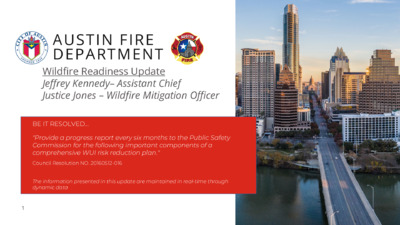Item #5 Austin Fire Department Wildfire Readiness Update Presentation — original pdf
Backup

AU ST IN FIRE D EP AR TMENT Wildfire Readiness Update Jeffrey Kennedy– Assistant Chief Justice Jones – Wildfire Mitigation Officer BE IT RESOLVED... "Provide a progress report every six months to the Public Safety Commission for the following important components of a comprehensive WUI risk reduction plan." Council Resolution NO. 20160512-016 The information presented in this update are maintained in real-time through dynamic data 11 Wildfire Readiness Update 1. The number of local CWPP’s completed and implemented. 2. The number of local CWPP's started but not completed. 3. The percentage of high-risk WUI areas in which identification of potential local CWPP planning areas is ongoing. 4. The number of public presentations and home assessments provided. 5. The number, size, type and location of fuel mitigation activities conducted. 6. The number of training hours received and conducted. 2 2 1) The number of local CWPP's completed and implemented is 23. Local level CWPP’s are community led initiatives that AFD facilitates and supports. We have 20 Firewise Communities ‘In Good Standing’ and another 3 communities that are ‘Inactive’. Wildfire Division staff are currently re-engaging with those communities. Barton Hills community is on track to become our newest Firewise community in the next six months. AU ST I N CW PP ’ s 3 2) The number of local CWPP's started but not completed is 23. Local level CWPP’s are community led initiatives that AFD facilitates and supports. Three of these communities have re-engaged with AFD in the last six months, and five communities are engaged to the degree where we anticipate them becoming Firewise in the next six months. Acti ve & En ga ged Sentence or subheading goes Here on the page in the header box. 4 3) The percentage of high-risk WUI areas in which identification of potential local CWPP planning areas is still ongoing is 49%. Of the 14% of Austin classified as high risk, 51% is covered by a local level CWPP, 49% are identified as opportunity zones. High R isk Ar ea s 5 4) The number of public presentations and home assessments provided in the past 6 months. 29 Presentations and events, and 55 home assessments provided. The Wildfire Division has taken measures in the last six months to dramatically increase our capability to provide home assessments. We have also increased our footprint in the Eastern Crescent. Outre ac h Acti vi ties 6 5) The number, size, type and location of fuel mitigation activities conducted in the past 6 months. 3 Prescribed fires (665 acres) completed, by assisting partner agencies. F u e l M i t i g a t i o n 7 6) The number of training hours received and conducted in the past six months. 84 Training hours received and 4,448 training hours conducted in the past six months, including the recently completed “Responding to the Interface” training. T rai ni ng Act ivi ties 8 Efforts to Connect with Vulnerable Populations • Developed strategy to identify and reach vulnerable population • Assignment of a Wildfire Mitigation Specialist to Outreach and Education, with a particular emphasis on assisting underserved communities and populations at risk from wildfires. • Actively updating the Community Wildfire Protection Plan, with a robust component focused on Diversity, Equity, and Inclusion and a clear roadmap for engaging and protecting vulnerable populations. • Collaborating with UT graduate students on research initiatives evaluating the equity of wildfire programs. • Established partnerships with community groups to distribute wildfire preparedness literature specifically tailored to vulnerable populations. • Outreach materials have been translated into multiple languages. • Working with individual community members in communities that do not have an organizing structure like an HOA. • The annual Wildfire Symposium was held at the Rosewood-Zaragosa Neighborhood Community Center in May. • Participated in disaster preparedness townhall meetings across the City of Austin. 9 • AFD Wildfire Division has also spearheaded the development of the Austin Wildfire and Vulnerable Populations tool, which is now the national standard used to gauge vulnerability to wildfire. • This tool can ID neighborhoods where wildfire threats and socioeconomic vulnerabilities may make people disproportionally susceptible to wildfire. • Began to identify communities at most risk and develop community risk assessment reports. 10 Qu est ions? More information can be found on these metrics and much more at ATXWildfire.org The information presented in this update are maintained in real-time in our new Austin-Area Wildfire Hub, accessible through our website 1111